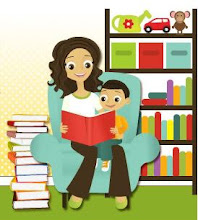Bats are often wrongly depicted as scary, dirty, blood-sucking creatures, so this is a good unit to do during this time of year because it will help your children (and some adults!!) distinguish between fact and fiction.
I would begin this unit by asking the children what they know about bats. Write down (but don't dispute) what the children say. At the end of the unit, go back to the chart and see if the children can identify things that were true and things that were not true. This is a good way for children to reflect back on what they have learned!
The books below are a combination of story books (like Bat Jamboree) and information books (such as Amazing Bats). It's a good idea to talk with the children about which books are story books and which books are information books so that they begin to learn the difference between "real" and "pretend."
Bats by Gail Gibbons

- Visit WildWatchCams and watch video of bats and live bat-cams!
- Bat Body Parts: Cut a large bat pattern and label the major parts of a bat. Here is a diagram from Enchanted Learning that can be adapted.
- B is for Bat: I am a fan of using a child's environment to teach literacy skills. So if you are studying bats, then it is a good time to reinforce the /B/ sound. Give children paper shaped like a bat and let them draw other things that begin with B.
- Rhyme Time: During small group time make "at" word families with the children: write the letters "at" on a sentence strip. On a cut-out of a bat, write other letters that will make words when added to "at". For example, write the letter "B" on a bat cut-out. When the children put the "B" in front of the "at" they will make the word "bat." Other "at" words: cat, fat, hat, mat, etc...
Bat Jamboree by Kathi Appelt

- Handprint Bat Craft: Use this template from First School
- This is a counting book so do some Bat Math! Check the local dollar stores or craft stores for bat stickers, which are easier to find during this time of the year. Give each child a sheet of construction paper with numbers written on it. The children should count and place the appropriate number of stickers on the paper. For younger children, you may want to use the numbers 0-5 while older children are likely to be able to count higher.
- Also read Bats Around the Clock (by the same author) and then dance like the bats in the book. You can also use this book to introduce time.
- Make play-dough and give the children bat-shaped cookie cutters.
- Bat Song from Kidsoup.com:
Bats Are Sleeping (Tune: Frere Jacques)
Bats are sleeping,
Bats are sleeping,
Upside down,
Upside down.
Sleeping in the morning.
Waiting for the night to come.
To fly around.
To fly around.
Zipping, Zapping, Zooming Bats by Anne Earle

- Bat Map: Show children a map (or globe) and place a bat shaped cut-out on all of the places bats live (everywhere except Antarctica)
- Helping Hands: Have children draw a picture of some ways that bats help us.
- Night Creatures: Introduce the word nocturnal. During circle time, have children think of other animals that are awake at night.
- Measure It! Use yarn (or links) to show the difference between bats' wingspans (some are as small as 3 inches while others are as wide as six feet).
Outside and Inside Bats by Sandra Markle  (Note: While this book may be geared towards older readers, preschool and kindergarten students will enjoy the facts and photographs; You may want to read certain parts of the book each day.)
(Note: While this book may be geared towards older readers, preschool and kindergarten students will enjoy the facts and photographs; You may want to read certain parts of the book each day.)
 (Note: While this book may be geared towards older readers, preschool and kindergarten students will enjoy the facts and photographs; You may want to read certain parts of the book each day.)
(Note: While this book may be geared towards older readers, preschool and kindergarten students will enjoy the facts and photographs; You may want to read certain parts of the book each day.)- Make a Slide Show that children can view on their own while visiting the Computer Center. (Here is a PowerPoint, Batty About Bats, that I made some time ago about bats. Some of the photos and information might be interesting and helpful. By uploading your PowerPoint to SlideShare, children can watch it at home with their families!)
- Visit the Organization for Bat Conservation. There are many resources and photographs.
- Provide the students with bat-shaped writing paper.
- Make bat finger puppets.
Bats at the Library by Brian Lies

- Take a Trip: If you have a public library close by, take a visit!
- Bats Everywhere: Make up a class story change the title (ex: Bats at the Mall, Bats at the Post Office, Bats at the Supermarket... etc).
- Using the class story created above, have children narrate the story and use Voice Thread to record their narration. Upload the story and illustrations and children can watch their story over and over again! They can also share it with parents and other family members.
- Read Bats at the Beach by the same author. Compare and Contrast the stories and/or illustrations.
Amazing Bats (Eyewitness Junior) by Frank Greenaway

- Learn more about Echolocation with this activity from Scholastic.
- Visit National Geographic for Kids Site about Vampire Bats
- Learn how dolphins also use echolocation.
- Bats are the only mammal that can fly. Make a list of the ways bats and people are alike (babies drink milk, baby bats need help from mother/father bat, have hair/fur, etc).
Stellaluna by Janell Cannon

- Put on a puppet show! Folkmanis makes some of the best puppets I've seen. Here is their bat puppet.
- Make a Venn Diagram comparing birds and bats. How are they alike? How are they different?
- Partner with another class that is also reading Stellaluna and share emails, letters,and/or drawings.
- Allow children to listen online to the story at Storyline Online.
- Watch the Foxy Fruit Bat Video from National Geographic for Kids.
- Make a Friendship List - Have children list the qualities of a good friend and talk about why Stellaluna and the bird became friends.
Bat Loves the Night by Nicola Davies

- Read the online story of Echo the Bat by Ginger Butcher and NASA. The story concludes with an activity that may be a bit advanced for younger students to complete on their own. But you can use the story to create your own age-appropriate "quest" for students to follow Echo.
- Make nighttime water color paintings: On day 1 give children water color paper, wide paint brushes and blue water color paint (The Liquid Water Color from Discount School Supply works well). Have them paint their whole paper blue. It's OK (and preferred) if the painting has various shades of blue. The next day, when the paint has dried, give the students thin paint brushes and tempera paints and allow them to paint a night scene - encourage them to include nocturnal animals!
- Make a class book about nocturnal animals. Have each child draw a picture of one animal that is awake at night. Bind all of the pictures together in a class book.
More Batty Resources

























Thanks so much for the Discount School Supply mention! What a GREAT post with SO many fun, "bat" ideas!
ReplyDelete-Laurel from Discount School Supply